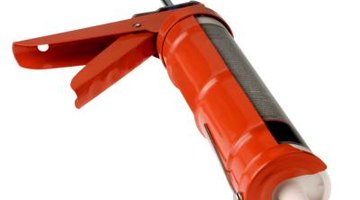Caulking to Stop Leaks in Pipes
Don't let that little leak under the sink go -- even with a bucket catching the drips, minor leaks encourage mold growth, and that can lead to major problems. Small leaks in the PVC pipe in your kitchen or bathroom may not require a professional repair if you're confident with a caulking gun. Even if your leak is heavy, caulk is still useful; it may seal the leak temporarily until a plumber can repair it.

Step 1
Turn off the water supply for the leaky pipe. Look for a shutoff valve near the wall; if there is no shutoff valve for the pipe, turn off the main water valve, typically located outside.
Step 2
Clean the outside of the pipe with a sponge and all-purpose cleaner. Allow the pipe to dry completely.
Step 3
Stick the tip of the caulk cartridge 1/8-inch into the nozzle cutter hole on the side of your caulking gun. Squeeze the caulking gun's trigger to cut off the tip. If your gun doesn't have a nozzle cutter, cut off the tip with a sharp knife at a 45-degree angle, cutting away from yourself.
Step 4
Pull the plunger on your caulking gun all the way back, with the notches facing up. Slide the caulk cartridge into the gun back end first. Gently release the plunger, and twist it so that the notches face down.
Step 5
Place the tip of the caulk cartridge at a 45-degree angle on the pipe joint. Squeeze the trigger gently to start the flow of caulk. Move the tip slowly until the entire area is sealed. Release the trigger before pulling the tip away.
Step 6
Smooth the caulk with a putty knife.
Step 7
Turn on the shutoff valve or main water valve. Allow the caulk to dry for 24 hours, or as directed by the manufacturer, before turning on the faucet.
References
Writer Bio
Delaware-based Daisy Cuinn has been writing professionally since 1997, when she became the features editor for her local biweekly music newspaper. She has been a staff writer and contributor to online and offline magazines, including "What It Is!," Celebrations.com and Slashfood. Cuinn holds a Bachelor of Fine Arts from Temple University.
Photo Credits
- Brand X Pictures/Brand X Pictures/Getty Images
More Articles



